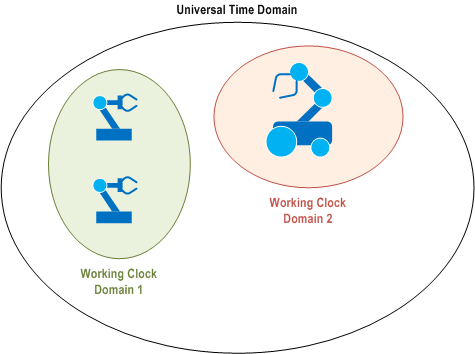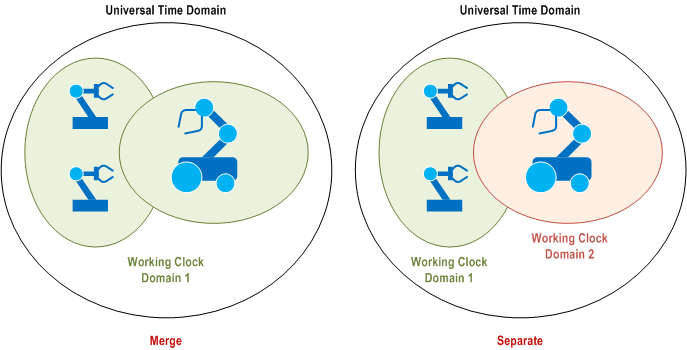Content for TS 22.104 Word version: 19.2.0
0f…
4…
5…
5.3…
6…
A…
A.2.2…
A.2.2.4…
A.2.3…
A.4…
A.4.4…
A.4.4.3…
A.4.5…
A.4.8…
A.5…
A.6…
B…
C…
C.3
C.4…
C.5
D…
E…
D 5G in industrial automation: different and multiple time domains for synchronization
D.1 Description
D.2 Merging of working clock domains
D.3 Time synchronization with 5G networks
D 5G in industrial automation: different and multiple time domains for synchronization p. 96
D.1 Description p. 96
The required synchronization precision is usually given as the maximum absolute value of the time difference between sync master and any device in the synchronisation domain (time domain or clock domain). A common example is a synchronisation precision of ≤ 1 μs. This is equivalent to ± the precision value, so ±1 μs between sync master and any device in the synchronisation domain, resulting in two times this value as maximum absolute time difference between any two devices in the synchronisation domain (2 μs in the example).
An industrial automation network generally consists of two distinct time domains.
First is the global time domain. This is the time used for overall synchronization in the system (e.g. the factory). It is used to align operations and events chronologically. Industrial automation uses the term universal time domain [20] for the global time domain described in this document. Global time is known as a synonym for universal time in industrial automation. Global time is called wall clock in certain areas and standards.
The synchronization precision is typically ≤ 1μs [20]. In some areas, a precision of ≤ 100 μs might be sufficient for the global time domain if a working clock with precision of ≤ 1 μs is available. The assigned timescale is usually the International Atomic Time (TAI, temps atomique international), based on the precision time protocol (PTP) epoch (starting from 1 January 1970 00:00:00 TAI) [22]. While there is usually only one global time, multiple global time domains are possible.
Clock synchronization in the global time domain usually applies to all UEs within the industrial facility in industrial automation. That is, a global time domain covers usually the industrial facility.
Second is the working clock domain. Working clock domains are constrained in size. They often consist of a single machine or a set of neighbouring machines that physically collaborate. The restricted size allows very precise time synchronization (≤1μs) with efficient network components. Synchronisation to a working clock is used to align e.g. production lines, production cells, or machines/functional units. In these cases, the application synchronizes locally within the working clock domains (Figure D.1-1), allowing precise synchronization with more efficient components. A global time domain usually contains multiple working clock domains. The starting point (epoch) is the start of the working clock domain.

The assigned timescale of a working clock domain is arbitrary (timescale ARB [22]). Therefore, different working clock domains may have different timescales and different synchronisation accuracy and precision. Robots, motion control applications, numeric control, and any kind of clocked / isochronous application rely on the timescale of the working clock domain to make sure that actions are precisely interwoven as needed.
Clock synchronization in the working clock domain is constraint in size. A specific working clock domain will contain only a subset of the UEs within the industrial facility. Often, the UEs of the working clock domain are connected to the same gNB. However, it is also possible that a working clock domain contains multiple neighbouring gNBs. This depends on the actual use case and its vertical application.
Devices may be part of multiple time domains leading to overlapping working clock domains.
The required precision (usually ≤ 1 μs) is between the sync master and any sync devices of the clock domain, both, global time domain and working clock domain.
Clock domains might be called sync domains in certain areas and standards.
D.2 Merging of working clock domains p. 97
One key issue of the integration of TSN and 5G wireless networks that has to be handled is mobility. The integration of 5G wireless communication into the industrial communication infrastructure allows for mobility in the manufacturing process. This mobility enhances flexibility in the manufacturing process, e.g. through adding certain manufacturing capabilities on-demand by having a machine move to the respective production line. This means that machines that are synchronized to different working clock domains may need to interact with each other.
The following scenario illustrates this. After the mobile machine has arrived at the intended location and is stationary again, the two interacting working clock domains have to be synchronized with each other. Otherwise interaction might not be possible without interfering with ongoing operations. An example is an autonomous mobile handling robot adding parts to an assembly line. Without synchronization between both, correct placement of the parts would be impossible.
However, it is not feasible to schedule these interactions beforehand. Therefore, the interaction between different working clock domains requires a concept for handling the communication. TSN provides already mechanisms for this. The 5G systems and the UEs need to provide an interface in order to exchange information of the clock domain.

When members of different working clock domains interact, there are two possible options (Figure D.2-1). Which option is used depends on the application and its requirements.
- Merge: The working clock domains merge into one. This option can be used in applications where synchronization is critical, e.g. high precision robots interacting with each other.
- Separate: The members of the different working clock domains interact while keeping their own separate time synchronizations. This option can be used in applications where synchronization is non-critical, e.g. an AGV collecting finished products from a production line.
D.3 Time synchronization with 5G networks p. 98
For the time synchronization with 5G networks, we consider two possible options.
The 5G system uses the IEEE 802.1AS sync domains [22]: In this case, the 5G system provides a media dependent interface to the IEEE 802.1AS sync domain, which the application can use to synchronize to the sync domain. In the IEEE 802.1AS standard [22], a similar concept is detailed in the MDSyncSend and MDSyncReceive structures.
The 5G system provides the working clock domains and global time domain: In this case, the 5G system has to provide an interface which the application can use to derive their working clock domain or global time domain. A device can belong to multiple working clock domains. An application can use each of these as the reference clock for synchronization (reference clock model).